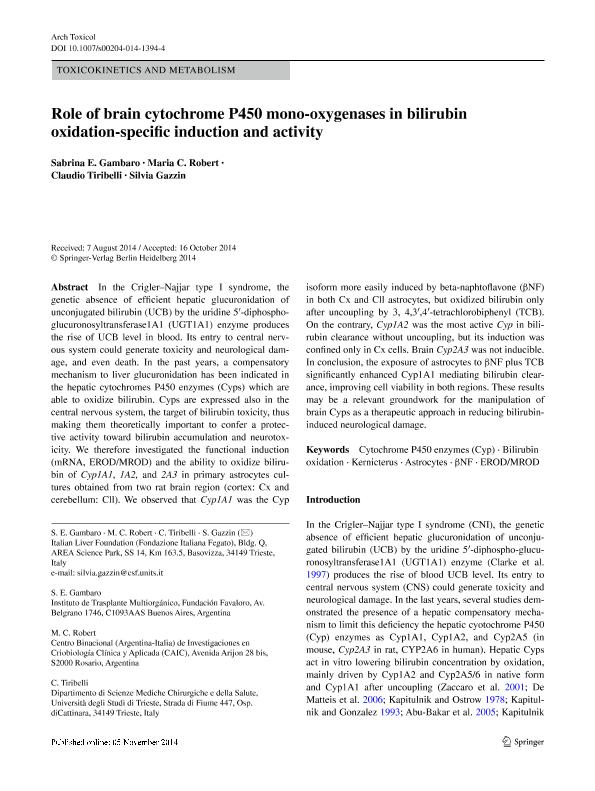Artículo
Role of brain cytochrome P450 mono‑oxygenases in bilirubin oxidation‑specific induction and activity
Fecha de publicación:
11/2014
Editorial:
Springer
Revista:
Archives of Toxicology
ISSN:
0340-5761
Idioma:
Inglés
Tipo de recurso:
Artículo publicado
Clasificación temática:
Resumen
In the Crigler–Najjar type I syndrome, the genetic absence of efficient hepatic glucuronidation of unconjugated bilirubin (UCB) by the uridine 5′-diphospho-glucuronosyltransferase1A1 (UGT1A1) enzyme produces the rise of UCB level in blood. Its entry to central nervous system could generate toxicity and neurological damage, and even death. In the past years, a compensatory mechanism to liver glucuronidation has been indicated in the hepatic cytochromes P450 enzymes (Cyps) which are able to oxidize bilirubin. Cyps are expressed also in the central nervous system, the target of bilirubin toxicity, thus making them theoretically important to confer a protective activity toward bilirubin accumulation and neurotoxicity. We therefore investigated the functional induction (mRNA, EROD/MROD) and the ability to oxidize bilirubin of Cyp1A1, 1A2, and 2A3 in primary astrocytes cultures obtained from two rat brain region (cortex: Cx and cerebellum: Cll). We observed that Cyp1A1 was the Cyp isoform more easily induced by beta-naphtoflavone (βNF) in both Cx and Cll astrocytes, but oxidized bilirubin only after uncoupling by 3, 4,3′,4′-tetrachlorobiphenyl (TCB). On the contrary, Cyp1A2 was the most active Cyp in bilirubin clearance without uncoupling, but its induction was confined only in Cx cells. Brain Cyp2A3 was not inducible. In conclusion, the exposure of astrocytes to βNF plus TCB significantly enhanced Cyp1A1 mediating bilirubin clearance, improving cell viability in both regions. These results may be a relevant groundwork for the manipulation of brain Cyps as a therapeutic approach in reducing bilirubin-induced neurological damage
Archivos asociados
Licencia
Identificadores
Colecciones
Articulos(CCT - ROSARIO)
Articulos de CTRO.CIENTIFICO TECNOL.CONICET - ROSARIO
Articulos de CTRO.CIENTIFICO TECNOL.CONICET - ROSARIO
Citación
Gambaro, Sabrina Eliana; Robert, María Celeste; Tiribelli, Claudio; Gazzin, Silvia; Role of brain cytochrome P450 mono‑oxygenases in bilirubin oxidation‑specific induction and activity; Springer; Archives of Toxicology; 90; 2; 11-2014; 279-290
Compartir
Altmétricas




